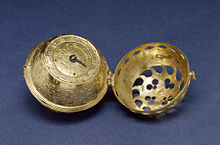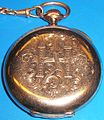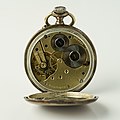pocket watch

portrait of the Danzig Hanseatic merchant Georg Gisze in London , detail)
A pocket (also Sackuhr ) is a clock which at a chain in a trouser or jacket pocket (so-called dress-coat pocket) is worn. Ladies often wore pocket watches on a chain around their necks or around the waist. Pocket watches have largely gone out of fashion today and have been replaced by wristwatches .
history
The development of pocket watches became possible after the spring drive was invented in the early 15th century . The oldest surviving clock with a spring drive (and the associated worm for regulating the rate) dates from around 1430 and is kept as "The Clock of Philip the Good of Burgundy " in the Germanic National Museum in Nuremberg. Until then, mechanical clocks were powered by weights.
Peter Henlein (around 1479–1542) from Nuremberg was one of the first German-speaking manufacturers to incorporate this spring drive into a portable clock around 1511 in conjunction with an inhibiting mechanism for the spring brake. So he could reduce it to pocket size. This pocket watch is shaped like a can (hence also called a portable can watch ) and was probably carried in a bag. A copy can be found e.g. B. in the Germanisches Nationalmuseum in Nuremberg. The "invention" was long ascribed to Peter Henlein from Nuremberg (around 1504/1509), but today research tends to assume a longer lasting development; however, his clocks are among the oldest surviving examples. Peter Henlein's contribution to this is speculatively accepted on various occasions as the inventor of the stackfreed . However, as is still falsely claimed, these clocks do not have the name Nuremberg Egg because of their egg shape. The name is rather a corruption of "Aeurlein", meaning Ührlein. What is certain, however, is that southern Germany, especially the two important trading cities of Nuremberg and Augsburg, was a center of early watchmaking .
The owner of one of the oldest surviving pocket watches (dated 1530) is said to have been Philipp Melanchthon.
The oldest representation of a watch that can be worn on the body can be found in the painting Der Kaufmann Georg Gisze by Hans Holbein the Elder. J. (1532). In the early days, these can clocks were mainly made in southern Germany, but also in France and probably in Italy. An early can clock (in the National Museum in Copenhagen) dates from 1533 and was probably made by Hans Zelltner, a Viennese court clockmaker. manufactured. These clocks in cans - which were probably carried in pouches - first developed into portable neck watches that were worn on a chain or ribbon around the neck (from 1530/40). Early portable watches had unrest escapements (either as wheel unrest or as spoon unrest). Due to the resulting inaccuracy , they were all equipped with only one hand (hour hand). It was not until the middle of the 17th century that the first pocket watches with a spindle escapement were made and then equipped with a minute hand. Examples from the 16th century are very rare and can only be found in important watch collections.
Most of the older pocket watches (it is estimated that over 80%) are unsigned, as it was not customary to add company names and logos until the 19th century. Today they can often only be assigned to certain manufacturers on the basis of specific designs or engravings.
The industrial production of pocket watches began in the mid-19th century. Even if prices fell as a result and thus no longer only the wealthiest classes could buy a pocket watch, it remained a status symbol. Solid clocks with silver cases were now widespread among the bourgeoisie and wealthy farmers, while gold clocks with particularly elaborate movements were a luxury item for the rich. Pocket watch production reached its peak in the period around 1900 and most of the examples still in existence today come from this period. After the First World War, the pocket watch increasingly went out of fashion and the wristwatch prevailed.
Housing designs
Around the middle of the 16th century, watch cases for portable clocks were usually box-shaped or spherical, more rarely oval. Only later did the wall become more bulbous, before the flat shape of the pocket watch, which is still familiar to us today, emerged. In addition, there was a large number of form clocks , especially at the end of the 16th century , depicting crosses, shells, stars, and occasionally skulls.
- Muskrat clock : the oldest reliably verifiable design (from approx. 1520), in the form of a small ball with an internal dial and movement. Such a clock is said to have been in the possession of Philipp Melanchthon.
- Can clock: early design (from approx. 1530), in the form of a small can without a lid. Usable as a table clock and portable in a pouch
- Neck watch : in the form of a small flat box with an openwork metal lid and ring to be worn on a ribbon around the neck, later (from 1590) also with a rock crystal lid
- Cross clock : one of many shape variants of the case that were in fashion from the end of the 16th century to the end of the 17th century
- Savonnette : with spring cover, the winding crown is on the side.
- Semi-savonnette
- Lépine : without a lid, the winding crown is on top.
- Pilot pocket watch : with the dial rotated by 180 °, as the watch was hung upside down in the aircraft (Doxa, Stowa )
- Tailcoat watch : small in size and particularly flat
Status symbol
Artistically crafted pocket watches were (and in some cases still are) a symbol of wealth and nobility. In the past, it was only possible to acquire a pocket watch for the very wealthy, who could often be represented with it, such as Maria Teresa of Spain in the 17th century by the painter Diego Velázquez , who is shown in the picture with two pocket watches.
In many other portraits up to the 20th century, only the, mostly artistically designed, pocket watch chain is visible. With this the pocket watch was attached to the trousers or the doublet .
Components
See also
Isochronism , nurse watch , Peter Henlein
literature
- Mauritius Maximilian Mayer: What is the name of the inventor of the pocket watch? In: The Nuremberg history, art and antiquity friend. Volume 1, 1842, pp. 177-179.
- Reinhold Stäckel: The Marfels watch collection. Comprehensively interesting pocket watches since they were invented. Frankfurt am Main 1889.
- Gustav Speckhart : Was the Nuremberg locksmith Peter Hele the inventor of the pocket watch? In: Antiques Newspaper. Central organ for collecting, auctions and antiquity. Volume 4, Issue 1–23, 1896, pp. 10, 17, 25 f., 41 f., 146, 154, 162, 170 and 178.
- Franz Maria Feldhaus : The striking pocket watch. A discovery about the cultural history of Nuremberg. In: Franconian courier. No. 252, (November 9th) 1933.
- F. Bauer: Pocket and wrist watches - production and special machines for toolmaking by Gebrüder Thiel GmbH, Ruhle, Thuringia. Leipzig 1938.
- Howard Maryatt: Watches. without location 1938.
- Enrico Morpurgo : Who Invented the Pocket Watch? Invitation to clarify. In: The watchmaker. Volume 12, 1951, p. 464.
- Ernst Zinner : Peter Henlein and the invention of the pocket watch. In: Yearbook of the German Society for Chronometry. Volume 4, 1953, pp. 8-12.
- Jürgen Abeler : Time signs. The portable watch from Henlein to this day. Harenberg Kommunikation, Dortmund 1983, ISBN 3-88379-362-0 .
- Catherine Cardinal: The time on the chain […] . Klinkhardt and Biermann, Munich 1985, ISBN 978-3-7814-0254-6 .
- Helmut Mann: Portrait of a pocket watch. 3. Edition. Munich 1986.
- Lukas Stolberg: Lexicon of the pocket watch. 4th edition. Klagenfurt 1995.
- Adolphe Chapiro: pocket watches. From four centuries . Callwey, Munich 1995, ISBN 978-3-7667-1171-7 .
- Reinhard Meis: pocket watches. From the neck watch to the tourbillon . 4th edition. Callwey, Munich 1999, ISBN 978-3-7667-1396-4 .
- Thomas Eser: The oldest pocket watch in the world? The Henlein watch dispute . Germanisches Nationalmuseum, Nuremberg 2014, ISBN 978-3-936688-92-4 . Digitized
- Dietrich Matthes: Have time - portable clocks before 1550 . Dover, 2018, ISBN 978-0-692-97945-7 .
- Dietrich Matthes: Corpus of the portable German can clocks of the 16th century. In: Thomas Eser: The oldest pocket watch in the world? The Henlein watch dispute. Verlag des Germanisches Nationalmuseums Nürnberg, Nürnberg 2014. ISBN 978-3-936688-92-4 , pp. 205–219.
- To the story of an indispensable . In: The Gazebo . Issue 36, 1867, pp. 575-576 ( full text [ Wikisource ]).
Web links
- Search for pocket watch in the German Digital Library
- mikrolisk.de (pocket watches and more ...)
- renaissanceuhr.de (clocks of the Henlein period)
- peterhenlein.de (oldest pocket watch from Peter Henlein 1505) - authenticity unproven.
Individual evidence
- ↑ Cf. for example Albert Gümbel : On the life story of Peter Henlein, the inventor of the pocket watch. In: The Bayerland. Volume 32, 1921, No. 20, pp. 332-335.
- ↑ Maia Wellington Gahtan, George Thomas, Philip Melanchthon's Watch Dated 1530. In: Antiquarian Horology. Volume 26, 2001, pp. 377-388.
- ↑ Dietrich Matthes: Corpus of the portable German can clocks of the 16th century. In: Thomas Eser: The oldest pocket watch in the world? The Henlein watch dispute. Verlag des Germanisches Nationalmuseums Nürnberg, Nürnberg 2014. ISBN 978-3-936688-92-4 , pp. 205–219, here: p. 218.










